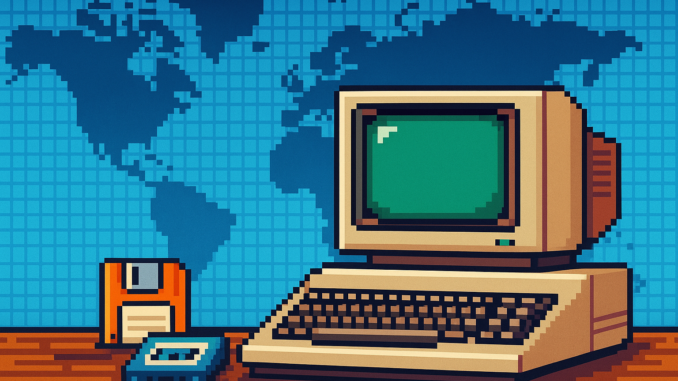
By The Editor, Netscape Nation
Introduction – Booting Up, Across the Globe
In the early 1980s, computing didn’t arrive with the thunder of a single moment. It seeped in through cassette ports and school corridors, flickered to life on green phosphor screens in bedrooms and back offices, and made its way across continents not through sweeping policy — but by sheer human determination.
We often tell the story of computing’s rise through a narrow lens: Silicon Valley’s glamour, or the BBC Micro wheeled into British classrooms. But the truth is much broader, messier — and far more interesting.
This series, Around the World in 8 Bits, aims to change that — by spotlighting the unsung computing revolutions of places like Australia, Brazil, Japan, Hungary, and South Africa.
Why Tell This Story Now?
Because retro computing isn’t just about nostalgia — it’s a global cultural history, scattered across import receipts, local magazines, and the hum of dial-up modems at midnight. It’s about what we built, not just what we bought. And in 2025, as technology becomes increasingly ephemeral, there’s value in remembering the hands-on, jury-rigged brilliance of the 8-bit era.
Every country had its quirks. Australia had the MicroBee. Japan had the MSX. France had the Thomson machines. Argentina, the C64 clones. These weren’t footnotes — they were centrepieces of childhoods, of careers, of dreams.
And yet, these stories are often overlooked.
That ends here.
What You Can Expect
Over the coming weeks, we’ll travel from the Outback to Osaka, from East Berlin to São Paulo, exploring:
- Local Legends: Home-grown machines like Australia’s MicroBee or Hungary’s Primo
- Import Workarounds: How systems like the ZX Spectrum or Apple II spread through unofficial channels
- Grassroots Education: Teachers, tinkerers, and teens who led revolutions in garages and classrooms
- Pre-Internet Networks: Local BBS scenes, modem clubs, and tape-swapping cultures
Each chapter will be penned by one of our senior writers, rooted in personal voices and regional expertise. It won’t be a list of specs — it’ll be a people-first chronicle of how computing took hold, often against the odds.
Why It Matters
Because technology didn’t emerge fully formed from Palo Alto. It evolved in tandem with communities — communities that deserve to be seen and remembered. Understanding their stories isn’t just history; it’s a blueprint for grassroots innovation today.
In an age of seamless cloud sync and AI-generated everything, it’s worth revisiting a time when you had to coax a game from tape, fix your RAM with elbow grease, and wait five minutes for BASIC to compile — and love every second of it.
So welcome. Whether you grew up with a MicroBee, a Spectravideo, or a rubber-keyed Speccy, this journey is for you.
Wherever you grew up — if you typed RUN on a flickering screen, these stories are for you.
Part 1: 8-Bit in the Bush – Australia’s Home Computing Revolution

Really glad to see this series. There’s a lot written about Silicon Valley, but not nearly enough about how people elsewhere tackled the same problems with far fewer resources. This does a good job of surfacing those stories and, frankly, makes the whole field a bit more honest.
Worth considering India and South Korea for future instalments. Both have distinctive stories—India’s knack for creative workarounds (“jugaad”) and South Korea’s investment in technical skills before it was fashionable. Either would add a lot.
Looking forward to what’s next.